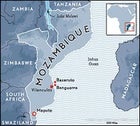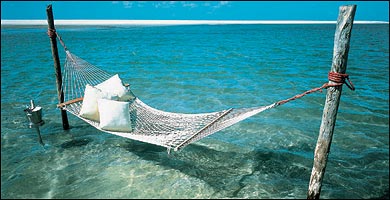I DIDN'T EXPECT TO HEAR TALES OF SMUGGLERS in a Mozambican bar named Smugglers, but stories about them circulated as liberally as the Laurentina beers: the Taiwanese long-liners pilfering fish in local waters, the Zimbabwean farmers who sneaked entire herds of cattle into the country rather than let Robert Mugabe seize them as part of his controversial reclamation of white-owned farmland. Whether the stories were apocryphal or not, they bestowed a sense of the frontier on the town of Vilanculos, on the coast of this 1,500-mile-long East African nation. Which is odd, considering that Portugal colonized it in the 16th century, then left in 1975 to watch from afar as a post-independence war brought it to its knees. But now, more than a decade after a 1992 peace treaty ended the civil war, the mood is upbeat, and travelers are discovering Mozambique, especially its tropical coast and a cluster of five islands whose coral seas and huge dunes are an integral part of the new beach-bush safari.
mozambique

The islands are collectively referred to as Bazaruto, although that's also the name of the largest in the quintetÔÇöand the 552-square-mile national park comprising them. (If that's not confusing enough, one of the islands, Benguerra, is also called Benguela, Benguera, and Benguerua.) Only Benguerra and Bazaruto have visitor accommodationsÔÇöand that's about all they have, besides fishing villages.
On the half-hour motorboat ride out to Benguerra, I kept a lookout for dugongsÔÇöthe area has the western Indian Ocean's largest population of sea cowsÔÇöbut I had to be content with watching dolphins swim alongside us and fishermen in old-style dhows sail across our bow.
Benguerra and Bazaruto islands have opened upmarket digsÔÇölike Benguerra Lodge, where 11 open-sided, Arabic-style bungalows tucked between acacia and Natal mahogany trees are presided over by Margie MacDuff. The vivacious Zimbabwean's friendliness and efficiency keep clients coming back for more.
The ambience is different at the newer Marlin Lodge, which is about three miles away but feels a lot farther, because you cross terrain ranging from swamp forest and dunes to mangroves and grasslands. Its 21 chalets are strung along wooden walkways above the beach, on either side of a large living/dining area. As a sign of the prosperous times both lodges are enjoying, each has been recently renovated, and Benguerra Lodge has added a pool and several suites.
With the whole archipelago offering some of the best coral reefs in the worldÔÇösightings of moorish idols, barred sweetlips, butterfly fish, and five types of turtle are commonÔÇödive centers are focal points at both lodges and at the Indigo Bay Island Resort, on Bazaruto Island. After breakfast each morning at Benguerra Lodge, I watched as a boat or two with divers set off for Two Mile Reef and the desertlike Pansy Island. I chose to stay ashore, lazily snorkeling or swimming or walking along the vast beach. Benguerra, like the other islands, is so sparsely populated that I could wander for miles without seeing anyone except fishermen poling their dhows close to shore.
Bazaruto is three times longer than Benguerra, and while shuttling there on a six-seater plane, I got some perspective on how a sandbar becomes an archipelago. Immense shifting dunes dominate the 23-mile island, and they are interspersed with forest and savanna and lakes inhabited by crocodiles. Up on a ridge, Indigo Bay Island Resort stands out as much as Benguerra's lodges blend in. The Moorish-style main building backs an infinity pool and 24 beach chalets.
While Bazaruto and Benguerra get the most publicity, and smaller Magaruque and Banque are rarely mentioned, it was the fifth island, Santa CarolinaÔÇömore frequently called ParadiseÔÇöthat fascinated me most. At Indigo Bay, I booked a day trip to Paradise, and along the way my guide explained how the island, the only rocky one, reflected the fortunes of the country as a whole. Though gorgeous, it's terribly frayed at the edges. During colonial days, a Portuguese businessman put up a confection of a resort, and the residents of Louren├žo Marques, the former capital, fell in love with it. But when the civil war began, Paradise closed down, and it's never reopened in its full glory. As we bobbed offshore, contemplating the old resort, my guide explained that a Zimbabwean had bought the right to run a concession on the island but hadn't done anything with it yet. Still, the trend is clear: Sooner or later, Paradise will be back in business.
ACCESS & RESOURCES
Mozambique's coast often turns into a side trip for anyone already heading to southern Africa, giving rise to something known as the beach-bush safari. Rates at the Benguerra Lodge (011-27-11-452-0641, ) are $340 per person per night; the Marlin Lodge (011-27-12-543-2134, ) charges $130ÔÇô$280. At Indigo Bay Island Resort (011-27-11-465-6904, ), the cost per night is $211ÔÇô$343 per person. (Rates include all meals and nonmotorized watersports.) Several lodges in South Africa's Sabi Sand Game Reserve and Kruger National Park, fewer than 300 miles away, have linked up with resorts in Bazaruto to offer travelers the beach-bush combo. Honeyguide (011-27-11-341-0282, ), which runs camps in the Manyeleti Game Reserve, bordering Kruger, and Leopard Hills (011-27-13- 737-6626, ), in Sabi Sand, has paired with Benguerra Lodge. The typical package includes seven nightsÔÇöthree at a game park, four on an islandÔÇöwith JohannesburgÔÇôKrugerÔÇôVilanculos flights, and costs $3,398ÔÇô$5,340 per person. A seven-night packageÔÇöincluding three nights at Chapungu Luxury Tented Camp, in the Thornybush Private Game Reserve, next to Kruger, and four nights at Indigo BayÔÇöcosts $1,944 per person, not including airfare (Esplanade Tours, 800-426-5492, ). A new international airport outside Kruger and daily flights to Vilanculos make this trip much easier now. The beach lodges have their own dive centers, with gear for snorkeling, scuba, watersports, and fishing. The latest to get in on the act is Dugong Beach Lodge ($250 per person per night, including all meals and nonmotorized activities; 011-27-11-883-7918, ), which faces the archipelago from the mainland south of Vilanculos. It's in the middle of Mozambique's first private game reserve, 70,000-plus-acre Vilanculos Coastal Wildlife Sanctuary. It has a tie-in with South Africa's Inzalo Exclusive Safari Destinations (), which runs camps in Thornybush, because wildlife in Mozambique was decimated during the civil war. Parks are being restocked, though, and work on the Great Limpopo Transfrontier Park, combining Kruger with parks in Mozambique and Zimbabwe, is well under way.


